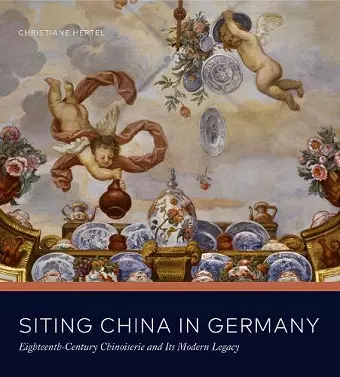Siting China in Germany
Eighteenth-Century Chinoiserie and Its Modern Legacy
Format:Hardback
Publisher:Pennsylvania State University Press
Published:10th Oct '19
Currently unavailable, and unfortunately no date known when it will be back

Chinoiserie—the use of motifs, materials, and techniques considered “Chinese” in ceramics, furniture, interior design, and landscape architecture—has often been associated with courtly decadence and shallow escapism. In Siting China in Germany, Christiane Hertel challenges conventional assumptions about this art form by developing a fresh, complex perspective on collections, gardens, and literature in the long eighteenth century.
From the extraordinary porcelain palaces at Dresden and Rastatt and the gardens of Wilhelmsthal and Wilhelmshöhe in Kassel to the literary and artistic translation practices in Dresden and Thomas Mann's historical novel Lotte in Weimar, Hertel interprets the extensive history of chinoiserie within but also beyond court culture. In particular, her study focuses on how manifestations of chinoiserie in Germany oscillated between the imagination, judgment, and critique of cultural and historical difference as well as identity.
Hertel’s erudite analysis of the cultural significance of German chinoiserie will interest art historians and scholars of Orientalism, German Sinophilia, and German Sinophobia.
“In this erudite book Hertel makes an important contribution to the recent reassessment of chinoiserie.”
—K. R. E. Greenwood Choice
“The process by which a culture regards another is complex. That ambivalence lies at the center of Christiane Hertel’s brilliant study of chinoiserie, the so-called Chinese taste, as it developed in eighteenth-century Germany. Hertel demonstrates how this seemingly frivolous, disconnected evocation of a distant land was a process by which Germany negotiated its place in an ever-changing world, with its effects detectable in twentieth-century German literature and German Expressionist painting. Her profoundly insightful study results from a deep, career-long knowledge of its subjects.”
—Michael Yonan, author of Empress Maria Theresa and the Politics of Habsburg Imperial Art
“Hertel deftly weaves visual, textual, and philosophical materials together to produce a fresh, critical study of the Germanic engagement with China in the eighteenth century. Siting China in Germany provides a major contribution to the recent critical integration of lesser-analyzed visual materials into the more familiar analysis of textual history. It also makes a major contribution to the current scholarly reassessment of chinoiserie, offering a new interpretation of German chinoiserie that situates the visual within a broader cultural and intellectual framework.”
—Stacey Sloboda, author of Chinoiserie: Commerce and Critical Ornament in Eighteenth-Century Britain
“In this beautifully written book, Christiane Hertel ‘sites’ China across a range of eighteenth-century German court arts, allowing the reader to travel between imagery as varied as silhouettes, the ‘Chinese’ village of Mulang, commedia dell’arte, and dining utensils. Each ‘siting’ creates, or is informed by, frames, mediations, imitations, and assimilations that challenge our conceptions of what ‘China’ might have meant in the eighteenth century. The work’s most important contribution is its ability to open the decorative arts to interpretive acts akin to sophisticated textual readings.”
—Dawn Odell, Lewis and Clark College
“This is an exciting, if demanding, read, and the book will no doubt form a milestone in literature about the West’s fascination with and interpretation of the East. Each chapter could easily have been turned into a standalone publication, such is the depth and breadth of the material presented.”
—Alexandra Loske Journal of the History of Collections
“Christiane Hertel has given us a great deal to think about, including the freedom to see German chinoiserie in new ways.”
—Suzanne Marchand Central European History
“Hertel’s highly insightful, carefully researched, and generously illustrated book gives a voice to paintings, objects, monuments, gardens, artisans, patrons, and other figures previously unheard or unheard of. It tackles the intimidating complexity of the materially and culturally multi-layered objects associated with chinoiserie by carefully disentangling their seemingly contradictory meanings through the use of visual analysis, period texts, and translation theory. Siting China in Germany is a rich and complex book that constitutes a milestone on a road connecting Europe and Asia much traveled by artists and scholars alike.”
—Anna Grasskamp 21: Inquiries into Art, History, and the Visual
“Siting China offers not only what is quite evidently a major intervention in the study of German chinoiserie, but also a significant contribution to our understanding of chinoiserie as a phenomenon more generally.”
—Stephanie Howard-Smith 1650-1850: Ideas, Aesthetics, and Inquiries in the Early Modern Era
ISBN: 9780271082370
Dimensions: 254mm x 229mm x 28mm
Weight: 1678g
304 pages